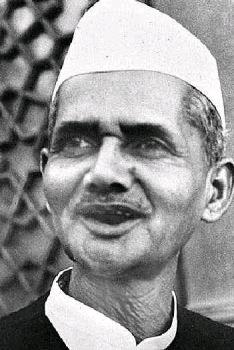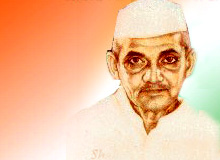
Lai Bahadur Shastri was India’s second Prime Minister. He was born in 1904, in a humble family. He was very laborious since his childhood. His honesty and simplicity was appreciated by people. He actively took part in the freedom struggle. He was a down-to-earth leader.
After the Independence of India, Shastri became the Finance Minister in Nehru’s Ministry. In 1964, Shastri succeeded Nehru as the Prime Minister of lndia.

He had not been in power long when Pakistan sent armed raiders into Jammu and Kashmir. Shastri promised to meet force with force and soon the second Indo-Pakistan war commenced. He gave the slogan ‘Jai Jawan Jai Kisan’. The Indian army reached the outskirts of Lahore.
The United Nations intervened and a cease-fire was declared. In 1966, the Russian Prime Minister, Alek Sei Kosygin, invited Shastri and Agha Khan for a summit in Tashkent where Shastri suffered a fatal heart attack.

He devoted his life for the pride and honor of the country. Shastri was regarded as man of principles. Lal Bahadur Shastri offered his resignation as Union Railway Minister; hours after he was made aware of a train accident that killed around 150 people. He laid the foundation stones of the well-productive schemes like Green Revolutions and White Revolutions. He was the first person to be posthumously awarded the "Bharat Ratna".

His Role In The Freedom Struggle
At the age of 17, he was very impressed with Gandhiji's call for freedom through non - violence and so took part in the Non - co-operation Movement of 1921. He courted arrest but was let off because of his age. But he was not so lucky when he followed Gandhiji in the Satyagraha Movement and spent approximately 8 years in jail over a period of time. Even though he was made to undergo tremendous hardships, he survived with the help of his prayers and physical exercises. He spent this time reading different authors like Hegel, Kant, Marx, Russell and Lenin. He also did some translations and wrote about the Quit India Movement.
Post Independence
He served the Congress in various positions before becoming Prime Minister. He was First General Secretary, and then Home-Minister. In U.P. he made some progressive reforms in the police department, and in 1962, Pandit Nehru invited him to join the Union cabinet as a Minister for railways. A post from which he resigned after taking responsibility for a railway mishap, that happened during his tenure.
Lal Bahadur Shastri showed remarkable abilities of oratorship and courage during the Indo - Pakistan War. He inspired his people through his leadership and offered them a slogan that has been passed down the ages - 'Jai Jawan Jai Kisan'. The Indo - Pak war would have continued, but fortunately, the Russian Government intervened and both India and Pakistan were forced to sign the 'Tashkent Agreement' on January 11, 1966. A day that saw the passing away of this great leader, just a few hours after signing this historic agreement.
He was awarded the 'Bharat Ratna' posthumously, in light of the services rendered to the country. His memorial 'Vijayghat' in delhi is a constant reminder of a great administrator and a fantastic human being.
Active Nationalist
In 1930, Lal Bahadur Shastri became the secretary of the Congress party and later the president of the Allahabad Congress Committee. He played a crucial role during the "Salt Movement". Lal Bahadur lead a door-to-door campaign, urging people not to pay land revenue and taxes to the British authority. The leader was also sent to jail for the campaign. During the long span of nine years he spent in jails, Lal Bahadur utilized the time in reading the social reformers and western philosophers. He was one of the leading and prominent faces that continued the Quit India movement, called by Mahatma Gandhi. Lal Bahadur, in 1937, was elected to the UP Legislative Assembly.
Death
Lal Bahadur Shastri, who had earlier suffered two heart attacks, died of the third cardiac arrest on 11 January, 1966. He is the only Indian Prime Minister, to have died in office, overseas. Lal Bahadur Shastri was the first person to be posthumously awarded the Bharat Ratna, (India's highest civilian award).


No comments:
Post a Comment